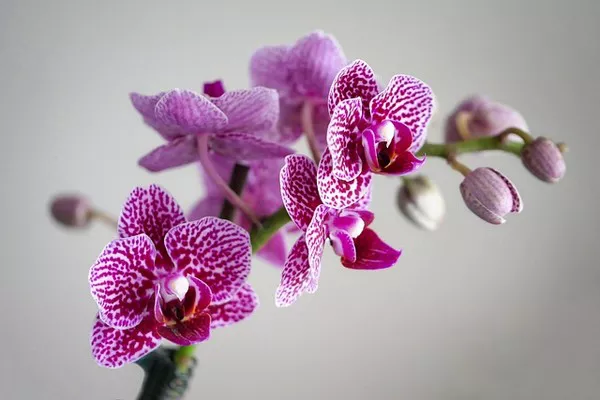Orchids, with their exquisite beauty and diverse forms, have captivated human fascination for centuries. These delicate and alluring flowers have a rich history, and their origins are as fascinating as their intricate blooms. In this article, we delve into the mysterious world of orchids to uncover their roots and explore the journey that brings these enchanting flowers into existence.
Evolutionary History:
The story of orchid flowers dates back millions of years, weaving through the intricate tapestry of Earth’s evolutionary history. Orchids belong to the Orchidaceae family, one of the largest and most diverse flowering plant families on the planet. Fossil evidence suggests that orchids have been evolving for at least 80 million years, with their ancestors likely emerging during the late Cretaceous period.
Orchids have adapted to a wide range of habitats, from tropical rainforests to arid deserts, showcasing their remarkable resilience and adaptability. Over the course of their evolutionary journey, orchids have developed unique features that set them apart from other flowering plants, contributing to their mystique.
Reproductive Strategies:
Orchids are renowned for their intricate and often peculiar reproductive strategies. Unlike many plants that rely on wind or insects for pollination, orchids have evolved specialized mechanisms to ensure successful reproduction. One of the most notable features is the complex structure of their flowers, which plays a crucial role in attracting specific pollinators.
Many orchid species have co-evolved with particular pollinators, such as bees, moths, butterflies, and even hummingbirds. The alluring colors, patterns, and fragrances emitted by orchid flowers serve as an irresistible invitation to their designated pollinators. As the pollinator interacts with the flower, it inadvertently aids in the transfer of pollen, facilitating the fertilization process.
Origins of Orchid Seeds:
While the intricate dance of pollination is a key aspect of orchid reproduction, the journey of orchid flowers truly begins with the formation of seeds. Orchid seeds are minuscule and lack the traditional nutrient reserves found in most seeds. Unlike other plants, orchids produce dust-like seeds that are incapable of germinating independently.
Orchids have forged a unique partnership with mycorrhizal fungi to overcome this hurdle. The tiny orchid seeds rely on fungi to provide essential nutrients for germination and early growth. This symbiotic relationship between orchids and fungi is crucial for the survival of orchid species, as it enables them to thrive in a variety of environments.
Germination and Growth:
The journey from seed to mature orchid plant is a remarkable process that requires patience and resilience. Once the orchid seed has successfully attached itself to the mycorrhizal fungi, a delicate dance begins. The fungi supply nutrients to the developing orchid embryo, allowing it to germinate and establish itself.
Orchids exhibit slow and intricate growth patterns, with some species taking several years to reach maturity. During this phase, the orchid undergoes a series of developmental stages, with the mycorrhizal fungi continuing to play a crucial role in providing essential nutrients. As the orchid plant matures, it gradually becomes self-sufficient and capable of producing its own energy through photosynthesis.
Environmental Adaptations:
Orchids have evolved a myriad of adaptations to thrive in diverse environments around the globe. From the epiphytic orchids that cling to trees in tropical rainforests to the terrestrial species found in temperate regions, each orchid has honed its characteristics to suit its specific habitat.
One notable adaptation is the presence of pseudobulbs in some orchid species. These bulbous structures serve as storage organs, storing water and nutrients during periods of scarcity. This adaptive mechanism allows orchids to withstand challenging environmental conditions and periods of drought.
Human Cultivation and Hybridization:
The allure of orchids has not been lost on humans, who have been cultivating these flowers for centuries. Orchid cultivation has a rich history, with enthusiasts and horticulturists dedicated to unlocking the secrets of these captivating plants. The Victorian era, in particular, witnessed a surge in orchid mania, with collectors and explorers venturing into remote corners of the world to discover new orchid species.
The practice of hybridization has played a pivotal role in expanding the diversity of orchid varieties available today. Skilled orchid breeders carefully cross different species to create hybrids with unique characteristics, such as vibrant colors, novel patterns, and increased resilience. The art of orchid hybridization has become a specialized field, with orchid shows and competitions showcasing the stunning results of these breeding efforts.
See Also How To Plant Flower Seeds In The Ground
Conclusion:
The journey of orchid flowers, from their evolutionary origins to their intricate reproductive strategies and unique growth patterns, unveils a captivating story. Orchids, with their unparalleled beauty and complex adaptations, continue to enchant and inspire both scientists and enthusiasts alike. As we delve deeper into the mysteries of orchid biology, we gain a greater appreciation for these extraordinary flowers that have graced our planet for millions of years. Whether in the wild or cultivated in gardens, orchids remain a testament to the wonders of nature and the intricate connections that shape the diverse tapestry of life on Earth.


